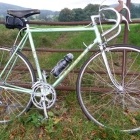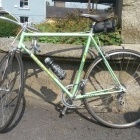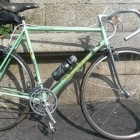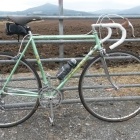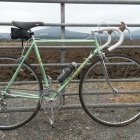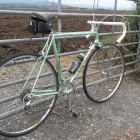
Section 11: Road Testing
First Test
This I would call the "confidence test" as it is very scary getting onto a bike that you have completely assembled from scratch, every nut & bolt. What have I forgotten? I took out a set of tools and resolved to test every nut and bolt, then I got bored after I shook the handlebar and stem, so I decided to just "go for it". Took the bike outside, we live on a slight hill, so discretion dictated I walk up to an ajoining road which was on the level, and try it there. Up and down a few times, tried the gears, the brakes, everything worked as it should (says a lot for my initial adjustments while assembling - another plus for friction shifters/gears too). Although I immediately noticed that vintage brakes are not for stopping - they are for "slowing down", I must keep this in mind for the future. After that I brought the bike down and up the hill to home, noting that there were no creaks from the bottom bracket on the uphill - very reassuring. What I noticed most was the silence from the mechanicals, the hubs were very quiet, the gear changes were inaudible (no problem sneaking up on other cyclists with this bike), and the bike felt very natural. I need to put on better tyres (the tyre were the originals which came with the wheels and had a few flaws) and take it for a long leisurely cycle (and hopefully back home) without incident. That's the next test.
Before the Real Test
From some photos I had taken of the bike, I noticed that I had not aligned the rear brake blocks properly. Fixed this.
Replaced the worn tyres and tubes, that came on the wheels, with a set of Continental Gatorskins that I had lying around, and then I did a second "confidence test" (again within the estate and just for fun) and afterwards noticed that the headset was a bit loose. It needs two large spanners to tighten it properly and I only had one (an adjustable wrench) that fitted. Using the wrench and my other hand to hold the headset did not really work. I had 3 identical old bike spanners, of the "flat steel with many cut-outs for different sized nuts" variety. These were, I think, supplied with bikes when bought in the 60s/70s/80s (or maybe only by Raleigh?). These all had a headset nut cut-out but it was wrong size (imperial instead of metric?). I decided to modify one of the three using a recently purchased, and as yet untried, angle grinder. I'd never used an angle grinder before and this was a good way to get experience. Made the modification, gradually and checking the fit frequently until satisfied. Then I tightened up the headset.
Real Initial Test
Ok, I broke this test into two (actually three).
- One afternoon I did a quick 10k on my own which brought me up and down a few hills and over some flat sections. Some of it took me into quiet roads of foothills of the Dublin Mountains. The bike was fast and quiet, everything felt "tight" and it was easy to be confident on. The gear changes were very light and very silent - reflects very well on my Simplex SLJ levers and I can appreciate why they were considered the best in th eworld in their day. I did have a habit of changing up, or down, two gears at a time but I put this down to the "lightness of their feel". Headset seemed to be still tight and all other components were fine.
- The next morning, I set out with Ann for Enniskerry in Wicklow (a total round trip of 40k) a route which would bring in a few more hills although still of the easy sort. The bike was perfect and I was really getting used to it - gear changing was perfect. There was some squeal from the rear brake, it may be dust on the rims or brake block, so I'll wait some more before I take any action. I did the "frame alignment" test by cycling with no hands (not one of my habits) and the bike held the line and went straight. I knew the frame always looked true and straight, now I knew it was. Without a speedo (its a vintage and a computer would look out of place on it) I had no ideas of actual speeds, however I did take on my favoutite traffic speed sign and registered 45kph on the flat (max I've ever got against this sign was 51 and only once, I have had lots of 47s, 49s etc) and with friction shifters its easy to change up into too high a gear too soon, which is exactly what I did, so there is plenty of room for improvement with this bike. A very successful first real test. When I got home, I did notice that my headset had loosened a bit, so I tightened it up a bit more - think I got it right this time. Also, my handlebar tape arrived later that day and I put it on - a nice white (here's to keeping it clean) colour.
- Later that same week, I did a similiar cycle to Enniskerry with Ann, but this time a little longer, 50k, and took in a pretty stiff hill of about 600m with an average 10% incline. Also, we were overtaken by a cyclist approaching another hill who didn't even bother to say hello (one of my pet hates), so I gave him a 100m headstart and then caught & passed him on the hill - the bike passed the test and he was pretty peed off to be passed by an old guy on (what I reckon looked like to him) an old boneshaker, Nice one, I thought. (If he didn't know enough to say hello, then he hardly new enough to recognise a good bike and with the non aero brakes and down tube shifters, my bike probably looked like a wreck to him - I have found a great way to have fun on the CFX-10). On the steep 10% hill, I kept it with a gear to spare and ran it in the 42x23 and there wasn't a squeak or creak from the bottom bracket. I will take it that the BB is a success subject to a few thousand kms to prove otherwise. The headset was still tight at the end of the cycle, so I think that is resolved, and the only thing outstanding is the squeal in the back brake when slowing down at high speed. I think I can work that out with a bit of perserverance. Oh, and I need to tighten the cable in the rear derailleur, I got the gears wrong when hitting a hill, slammed the lever all the way back to get to the lowest gear in a hurry, and it went further than it should have - the cable slipped a bit in the rear derailleur (the bit with the bolt that I had to file down) - I reckon I didn't tighten it enough. Will fix that in the next day or so.
Longer Test
Proving the adage in IT (where I spent all of my career) that "you can never do enough testing", early in 2015 - the longer test became a sequence of two cycles and my BB practically fell appart. I had done a 75km, slow but hilly cycle with some friends where I had attacked hard on a few hills, just to make the cycle tougher. Then followed it up with a 50km cycle, where the first 15km was on my own and hard/fast, and the remainder was in the company of my wife and a friend and was easy, except for the fact that I took one climb very, very, hard (I got a Garmin and was trying a Strava segment for a bit of craic). Before I got home my BB almost seperated and I was in real trouble - needed to get a lift home to prevent more damage. And a rethink of my BB solution - all this is detailed in Section 8 The Velo Orange Threadless BB.
A Real Test
A season of use, most of it gentle, but inspired by finding a vintage bike cycle organised in Ireland for September called Vintage International Classic as it commemorated 30 years since the Nissan International Classic started in Ireland, I entered and increased the training of which a lot of it was performed on the CFX-10. Fitted my old toe-clip pedals (to get used to them and cleats again) and as the Vintage Event was over some very tough hills in Kerry, I did a lot of my training on the CFX-10 in the Wicklow Mountains. The bike and the owner held up very well. Full details of the Vintage International Classic are in Section 13.1 OldVelos Vintage International Classic (and it was a very tough event in which the CFX-10 was faultless).
Contact me by email : alan_cowzer@hotmail.com
Contact me through Facebook : My Peugeot CFX-10 Facebook Page
© 2018- 2025 Alan Cowzer
